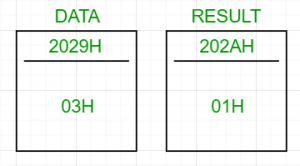8085 program to determine if the number is prime or not
Last Updated :
13 Jun, 2018
Problem – Write an assembly language program for determining if a given number is prime or not using 8085 microprocessor.
If the number is prime, store 01H at the memory location which stores the result, else 00H.
Examples:
Input : 03H
Output : 01H
The number 3 only has two divisors, 1 and 3.
Hence, it is prime.
Input : 09H
Output : 00H
The number 9 has three divisors, 1, 3 and 9.
Hence, it is composite.

A prime number is the one which has only two divisors, 1 and the number itself.
A composite number, on the other hand, has 3 or more divisors.
Algorithm:
- Take n as input
- Run a loop from i = n to 1. For each iteration, check if i divides n completely or not. If it does, then i is n’s divisor
- Keep a count of the total number of divisors of n
- If the count of divisors is 2, then the number is prime, else composite
How to find out if i is a divisor or not?
Keep subtracting i from the dividend till the dividend either becomes 0 or less than 0. Now, check the value of dividend. If it’s 0, then i is a divisor, otherwise it’s not.
Steps:
- Load the data from the memory location (2029H, arbitrary choice) into the accumulator
- Initialize register C with 00H. This stores the number of divisors of n
- Move the value in the accumulator in E. This will act as an iterator for the loop from n to 1.
- Move the value in the accumulator in B. B permanently stores n because the value in the accumulator will change
- Move the value in E to D and perform division with the accumulator as the dividend and D as the divisor.
- Division: Keep subtracting D from A till the value in A either becomes 0 or less than 0. After this, check the value in the accumulator. If it’s equal to 0, then increment the count of divisors by incrementing the value in C by one
- Restore the value of the accumulator by moving the value in B to A and continue with the loop till E becomes 0
- Now, move the number of divisors from C to A and check if it’s equal to 2 or not. If it is, then store 01H to 202AH (arbitrary), else store 00H.
202AH contains the result.
|
ADDRESS
|
LABEL
|
MNEMONIC
|
|
2000H
|
|
LDA 2029H
|
|
2001H
|
|
|
|
2002H
|
|
|
|
2003H
|
|
MVI C, 00H
|
|
2004H
|
|
|
|
2005H
|
|
MOV E, A
|
|
2006H
|
|
MOV B, A
|
|
2007H
|
LOOP1
|
MOV D, E
|
|
2008H
|
LOOP2
|
CMP D
|
|
2009H
|
|
JC DIVIDENDLESSTHAN0
|
|
200AH
|
|
|
|
200BH
|
|
|
|
200CH
|
|
SUB D
|
|
200DH
|
|
JNZ LOOP2
|
|
200EH
|
|
|
|
200FH
|
|
|
|
2010H
|
DIVIDENDLESSTHAN0
|
CPI 00H
|
|
2011H
|
|
|
|
2012H
|
|
JNZ NOTADIVISOR
|
|
2013H
|
|
|
|
2014H
|
|
|
|
2015H
|
|
INR C
|
|
2016H
|
NOTADIVISOR
|
MOV A, B
|
|
2017H
|
|
DCR E
|
|
2018H
|
|
JNZ LOOP1
|
|
2019H
|
|
|
|
201AH
|
|
|
|
201BH
|
|
MOV A, C
|
|
201CH
|
|
MVI C, 00H
|
|
201DH
|
|
|
|
201EH
|
|
CPI 02H
|
|
201FH
|
|
|
|
2020H
|
|
JNZ COMPOSITE
|
|
2021H
|
|
|
|
2022H
|
|
|
|
2023H
|
|
INR C
|
|
2024H
|
COMPOSITE
|
MOV A, C
|
|
2025H
|
|
STA 202AH
|
|
2026H
|
|
|
|
2027H
|
|
|
|
2028H
|
|
HLT
|
Store the value of n in 2029H. If 202AH contains 01H, then n is prime, else composite.
Share your thoughts in the comments
Please Login to comment...